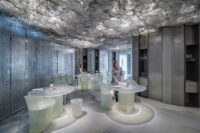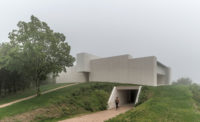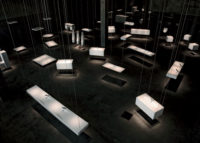Jump to Credits & Specifications
Poised mastery of minimalist spatial composition and building craft–with weathering steel plate as a major protagonist—is evident in every detail of the Soulages Museum, dedicated to the work of the French abstract artist Pierre Soulages and located in his hometown of Rodez, in southwest France. Evident too in the building, by RCR Arquitectes of Olot, Spain, is its sophisticated integration into its surroundings and its rapport with the artwork it houses, which was donated to the French State by the artist and his wife, Colette.
From a deep entry porch and lobby on the south, visitors descend to the gallery level via a staircase on one side, or they can access a bridge (which holds a small auditorium and leads to a café and restaurant) spanning the exterior stair. The low horizontal volume has two levels: a mezzanine housing offices and classrooms, and a large gallery space below it, which connects the pavilions of various sizes that are attached to it. This arrangement shapes what Vilalta describes as “an itinerary with a changing rhythm,” in which visitors weave in and out and around the gallery pavilions. While the low connector-gallery spaces are finished entirely in steel plate and daylit from north-facing window walls, the taller pavilions that interrupt them have contrasting walls of white plaster and receive indirect daylight from skylights above.
The architects worked closely with Soulages and his wife (the nonagenarian couple sat on the jury for the 2008 open competition for the project) to develop the galleries so as to meet the display requirements for different kinds of work and to create this varied procession. The horizontal exhibition space has a zone at its back protected from light, tucked under the mezzanine, where sensitive works on paper are shown. To the north, this connector space is interrupted by the three taller pavilions. These temple-like spaces form a high point of the experience, displaying particularly important groups of works: preparatory studies of Soulages’s stained-glass windows for a church in nearby Conques, his early paintings made with a walnut stain, and his large-scale works. A fourth pavilion is dedicated to temporary exhibitions. With their stark contrasts between dark and bright spaces and surfaces, and their serious, somber atmosphere, the galleries assume an elegant supporting role for Soulages’s work, in which single tones dominate—especially black on white—and where firm brushstrokes and solid color planes contain expressive gesture. There is an unmistakable dialogue between the building and the work it houses as they seem to whisper back and forth to one another, like partners in a dance.
The architects have built the museum almost entirely of coarse steel plate, inside and out, a material that they have worked with extensively, as in their Les Cols Restaurant in Olot (RECORD, September 2003, page 136). The Cor-Ten for the exterior is burnt in appearance, creating a mottled, painterly effect and echoing some of the battered, acid-etched plates for Soulages’s engravings. Vilalta also compares its reddish tones to the native stone of the town’s Gothic cathedral, which is visible from the park. For the floor-to-ceiling windows of the building’s low horizontal portion, RCR used deep fins of 6-millimeter-thick steel plate, following a 6-foot modular bay. Along the park-facing southern facade, exterior vertical louvers made of weathering steel screen the offices and teaching spaces.
Inside, RCR uses unpainted steel plate for every surface, with the exception of the walls and ceilings of the taller galleries. Floors have a waxed finish, which draws out the material’s varied colors. Walls and ceilings are varnished in a deep, more uniform hue (to hang the artwork here, the architects employed a magnet system). In contrast to the matte finish of the exterior, these surfaces respond to light with a burnished glow.
RCR has developed the restaurant space, run by local chef Michel Bras, with the same attention they dedicate to the galleries. Its exterior entrance offers one of many memorable experiences, leading visitors into a courtyard screened by a Cor-Ten steel grille, where a steel-slatted walkway crosses a reflecting pool lined with oversize basalt gravel— a sequence that reveals the influence of the architects’ travels in Japan.
In fact, a Zenlike, meditative calm and intensity can be felt throughout the building: in the architects’ use of material, texture, and rhythm; in the idiosyncratic organization; and in the exquisite, studied craftsmanship (realized with a tight budget of just $325 per square foot for the 65,700-square-foot structure, a feat that Vilalta attributes to the commitment of the entire building team). RCR’s refined sensibility is in harmony with Soulages’s artwork, which often has an Asian, calligraphic quality of its own, although the architecture always takes a backseat. The variety of the gallery spaces, with their dramatic contrasts of proportion and light, transform what might have been an overly uniform review of a single artist’s career into a coherent experience alive with surprise.
PeopleClient: Owner: Architect: Personnel in architect's firm who should receive special credit: Associate architect(s): Interior designer: Engineers: Consultant(s): Lighting: Acoustical: Scenography: Size: 65,700 square feet Construction cost: $21.4 million Completion date: January 2014 |
ProductsStructural system M. Grill'res Concrete: Lagarrigue M. Arnal M. Frayssinet M. Castes Exterior cladding Metal/glass curtain wall: Windows Glazing M. Taleb M. Le Gall M. Villiers Doors Metal doors: M.Bourdoncle M.Jalbert Fire-control doors, security grilles: M.Bourdoncle M.Jalbert Interior finishes M. Bonnefous M. Ledall Floor and wall tile: Special interior finishes unique to this project: Furnishings Fixed seating: Chairs: Esteve Verg's Picart Tables: Lighting Downlights: Dimming System or other lighting controls: Conveyance Plumbing |














Post a comment to this article
Report Abusive Comment